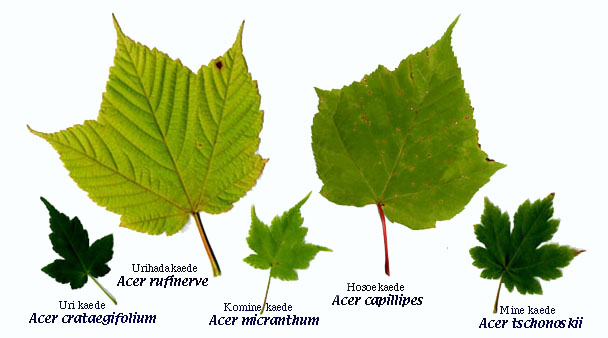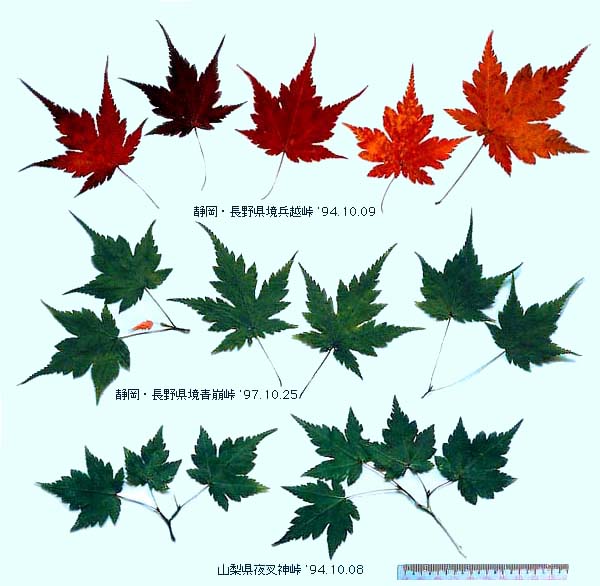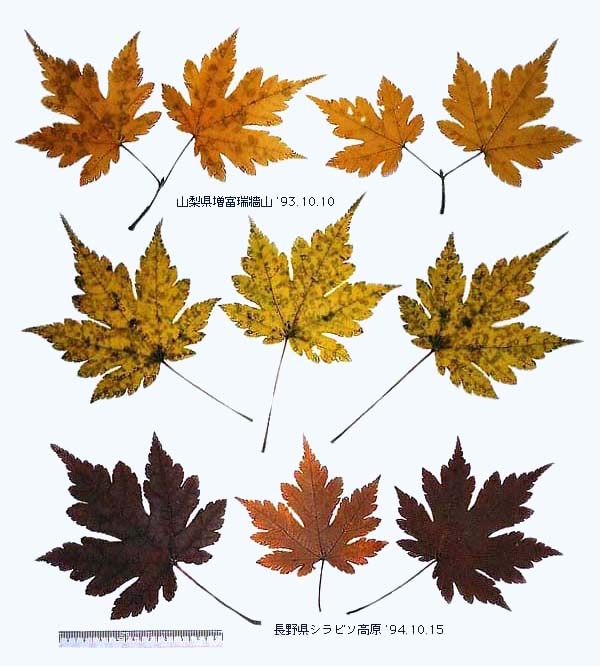
Friends of Acer capillipes, which are rich in similarity and diversity
In genus Acer, the character above mentioned is especially remarkable in case of series rufinerve. As families of series rufinerve seen in Japan, we can give those species such as A.crataegifolium, A.rufinerve, A.capillipes, A.insulare and A.morifolium. Moreover, A.tschonoskii, var.macrophyllum, A.australe and A.micranthum are also included, which are attractive to me above all, though I am afflicted with their discernment.

In addition, looking around maples of the world, this group is called Section Macrantha , and is known as Striped maples or Snakebark maples. These names come from the feature of the striped pattern which can be seen on the trunk.
According to "The Complete GUIDE TO TREES-of Britain and-Northern Europe" (by ALAN MITCHELL), on the colors of the striped pattern of the trunk, those maples are shown as typical examples as follows;
David's maple (A. davidii) in China is blackish green
Hers's maple (A. hersii, i.e., A. davidii ssp grosseri) the most greenish
A. capillipes in Japan reddish
A. rufinerve in Japan grayish
A. pensylvanicum in U.S.A. whitishOf course, A. crataegifolium is also carried as a small tree whose branches and stalks are slim. It is considered not so easy even for a specialist to discern the species perfectly only by a given leaf. As a whole, these small differences might be regarded as statistical variation. But there is another position, where these differences are considered so important that some species are classified into a subspecies, a variety or a form according to the degree of them.
Thus, according to persons there seem to be some grades in accordance with their interest and also seem to be different meanings of discernment.
Let me show you some examples of discernment, as follows;
1. Discernment between A.rufinerve and A.capillipes
2. Discernment among A.capillipes, A.insulare and A.morifolium
3. Discernment among A.tschonoskii, var.macrophyllum, A.australe and A.micranthumAcer rufinerve (left) & Acer capillipes (right)
A.rufinerve (left) There are brownish shrinked hairs on the axils of the main veins.
petioles are short & greenishA.capillipes(right) There are small membranes on the axils of the main veins, no hairs.
petioles are long & reddishA. Tschonoskii, A. micranthum and their companions which are the most difficult for me to discriminate
In case of mine-kaede and its companions, we should depend upon the difference of the flower, the size and the form of the seeds. It would be very nice to have a chance to see them at the right time when they are in bloom or they are with seeds, but it's not always so, then I am still perplexed at the discrimination of the mine-kaede group now. This group includes mine-kaede, ohba-mine-kaede, nangoku-mine-kaede and komine-kaede. They are my favorite leaf-shapes.
Let me show photos of leaves of Mine-kaede (Acer tschonoskii) family which can be seen in the Central Honshu, such as the Aokuzure Pass, the Hyogoshi Pass, Mt. Chausu, the Yashajin Pass, Yachiho Highland (Tadeshina, the Mugikusa Pass), Mt.Mizugaki (Masutomi), the Shirabiso Pass.


Maples & Japanese maples : Species discernment